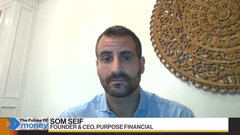Dec 31, 2021
The future of business leadership: Old-school micromanagers need not apply
Growth to be driven by skilled people from around the world reaching their goals in Canada: CIBC CEO
The global pandemic changed everything in 2020. Now it is going to change everything forever. In this is part of "The Future of" series, BNN Bloomberg looks at what is next for our transformed economy and daily lives.
When Michele Romanow closed her offices on March 10 for a work-from-home test run, she expected her 250 staff would come back that week. Nine months later, the president and co-founder of Clearbanc, a Toronto-based business that invests in e-commerce companies, is still waiting to return.
The first few weeks of lockdown were “like drinking out of a firehose,” she says. But once people adjusted, Romanow, who is also a Dragon on CBC’s Dragons’ Den, says she realized that her leadership style would have to adapt, too.
Her employees were all nervous about managing through a pandemic. And, she could no longer walk around the office and freely share ideas with staff. “We have a very high-touch culture,” Romanow says.
She quickly recognized that she needed to be more transparent than usual, communicate more often – she now holds multiple all-hands meetings in a week, when she used to have just two – and get to know her employees even better than before. “I needed to build trust in a different way,” Romanow explains. “I thought a lot about transparency and sharing more of myself, and making sure people were comfortable coming to me as a leader, which is easier to do in the office.”
Romanow’s leadership style required a tweak during the pandemic, she says, but others have experienced more profound changes in the way they lead. Many CEOs, for instance, have realized that the top-down, micromanager approach won’t cut it anymore. Employees now want to work with more caring, people-focused executives, and that won’t change after the pandemic ends.
“One of the fundamental differences is the importance of trust between employees and leaders,” says Michael Denham, a long-time executive who’s now president and CEO of the Business Development Bank of Canada. “Old-school leaders have had to change their approach to become more authentic, transparent and open – that will be a lasting change.”
MORE EMPATHETIC LEADERS
According to a survey from CEMS – a global alliance of business schools – which surveyed 1,700 business professionals in 70 different countries, resilience, empathy and the ability to communicate have become more important leadership qualities during the pandemic. Before COVID-19, just 13 per cent of people ranked resilience as a top-three leadership characteristic. Now, 34 per cent do.
While more traditional leadership abilities, such as having a strategic vision and being results-focused are still important, they’re not as critical as before. The survey found that while the former remained the No. 1 leadership quality, 68 per cent said it was now the most important characteristic compared to 74 per cent pre-pandemic. The latter’s importance fell to 49 per cent from 58 per cent.
- The future of work: How the pandemic's 'awakening' will shape Canada's labour force
- The future of play: Canada's entertainment industry races to rehearse for post-pandemic encore
- The future of travel: From rapid tests to immunization tracking, how COVID-19 will reshape tourism
THE FUTURE OF...
Arlene Dickinson, CEO of Venture Communications and also a Dragon’s Den judge, isn’t surprised by these kinds of results. Empathy will be one of the most critical leadership qualities going forward, she says, especially after bosses have heard the cries of their employees’ children and dogs barking on video calls. “We have all experienced suffering, and tapping into that is critical,” Dickinson says. “Putting yourself in someone’s shoes requires true leadership and understanding.
She also predicts more women leaders will arise from this crisis, as they tend to be more empathic, not to mention calm and communicative.
“You’re going to see a strong set of females come through this as evidence of what leadership can look like,” Dickinson says. “You see it on the world stage, with some female politicians being held up as demonstrating the type of leadership that’s now required.”
Dickinson admits she’s become more empathic during the pandemic. The long-time entrepreneur became a leader in a world where strong women were seen as difficult, while people-focused females were seen as too soft. Over the last few months, Dickinson says she’s been able to be more herself.
Like Romanow, she’s communicating more with staff and is trying to be as transparent as possible. “I feel like I can tap into all my learnings of the past, but also into who I am as a human,” she says. “I’ve definitely changed, and I feel like I’ve grown a lot.”
TRANSPARENCY IS A MUST
While not every leader is naturally empathic, most can be – at the very least – more transparent and authentic, says Denham. With so much uncertainty these days, employees have a lot of questions about their workplaces and the direction their companies take. Executives don’t need to share every revenue projection, but they should be open about their struggles and answer questions honestly, he says.
“You can’t just answer questions – there also needs to be a rationale behind the answers,” Denham says. “It’s fine if you say we’re going northwest rather than northeast, but you have to say why you’re doing that – why the course correction and how it is going to help the company? When you talk about strategy and direction, you need to be articulate as to why certain things are being done.”
Denham adds that while he’s always been a good delegator, the pandemic has helped him hone that leadership skill even more. With work-from-home arrangements making it difficult to keep tabs on employees, and executives realizing that they need to take better care of themselves, too, offloading responsibilities has become more important.
“My leadership style has been one of delegating to the team I have around me, but that’s required even more so now because it's hard for me to get a good, solid, independent view on issues with access to information being more difficult,” he says.
“I need to have even more confidence in my colleagues to make the right decisions – and I can get away with more delegating because the team I have is so strong.”
TIME TO BE BOLD
Going forward, more executives may be willing to take bigger risks, says Roger Martin, former dean of the University of Toronto’s Rotman School of Management and author of several leadership books. This is especially true of leaders who have kept their business afloat during the pandemic. “They’ve shown themselves that if they can get through and survive such an out-of-bounds event; that they survive anything,” he says.
However, Martin also sees another scenario where a group of more conservative leaders in industries that have been hit harder, arises. They may carry more cash, avoid debt and take growth more slowly, he says.
That’s not Romanow’s approach, though. She thinks that now is the perfect time for leaders to do something new or shift business models. The world has changed so much that consumer behaviour, which is notoriously hard to sway, has been forever altered. Executives and entrepreneurs need to take advantage, she says.
“There are no more weekend trips, no more late nights out – cancel your Netflix account and build your dreams this year,” Romanow says.
"Some of today's biggest companies started in the 2008 recession (Uber, Airbnb, Slack), and 2020 won't be any different. There's something about seeing all these problems and knowing we have the tech to help that inspires people.”
While a vaccine may help Romanow’s staff return to the office sometime next year, whether they come back or not, she knows that her leadership style can’t be the same. How can it be after going through a (hopefully) once-in-a-century pandemic?
“There’s going to be a lot of changes,” Romanow says. “You have to build trust in an organization in a different way. You need to be talking to employees on text, on video, in all-hands [meetings] – it’s going to be very different.”









